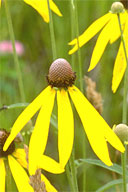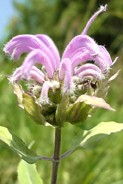Going native: Start your own wildflower garden from scratch
The coneflower is a given when compiling lists of popular wildflowers.
This prairie plant is beloved for its easy-going nature and long-lasting daisy-like blossoms blooms. It attracts bees, butterflies and other insects into the garden, and it's fun to watch goldfinches dangling upside down dining on seeds plucked from spent heads.
Narrow-leafed purple coneflower (Echinacea angustifolia) is an Iowa native, along with pale purple coneflower (Echinacea pallida) and purple conflower (Echinacea purpurea). A few areas of Iowa, mostly on our western edge, you'll find the yellow prairie coneflower (Ratibida columnifera) and the grey-headed prairie coneflower (Ratibida pinnata).
Black-eyed and brown-eyed Susans are prized, along with columbine (Aquilegia canadensis) with its cheerful red and yellow nodding blooms, wild bergamot (Monarda fistulosa) and butterfly weed (Asclepias tuberosa). New England aster (Symphyotricum novae-angliae, previously Aster novae-angliae) is among my personal favorites, and the first type of aster I ever planted. Monarchs passing through my fall garden find it a valuable source of nectar (and a landing pad to rest).
Search out a source for high-quality seeds and plants that are suited to your growing conditions --- location, soil type, sun exposure, etc. The National Garden Bureau, which has declared 2013 the "Year of the Wildflower," also suggests tracking down fact sheets and publications geared toward your geographic region, such as the Xerces Society (www.xerces.org) and the Lady Bird Johnson Wildflower Center's extensive database that can be searched by state (www.wildflower.org). Iowa State University Extension also has good resources for wildflower information.
To create your own wildflower garden, follow these NGB suggestions:
1. Prepare the soil by removing weeds and other unwanted vegetation. If the soil is compacted, till lightly so the soil is loose and germinating seeds can put down roots. A bow rake is great for loosening the top layer of soil. Digging or roto-tilling too deep will bring up weed seeds and other plants that will need to be removed later to avoid competing with the wildflower seeds. While it may not be practical or necessary to amend the soil before planting wildflowers, you can add organic matter such as compost or well-rotted manure before planting depending on the site.
2. Wildflower seed and seed mixes can be planted in either spring or fall. Spring rains help seeds germinate and plants get established before many weeds have a chance to grow. In cold climates, a dormant seeding of wildflowers can be done in the fall when temperatures are low enough that seed will not germinate until weather warms up the following spring, similar to what happens in nature. Some seeds, especially many of our native perennial wildflower species, need a chilling period to break their dormancy. This is provided naturally by the change in temperatures from winter into spring.
3. Scatter seeds by hand or with a small spreader. Seeds can be raked into the soil or lightly covered with soil. Water thoroughly right after planting and keep seeds and seedlings moist for about 4-6 weeks. Gradually reduce watering as seedlings develop. Identify and remove weed seedlings as soon as possible since they will compete with wildflowers for water, nutrients and space. For dormant seeding, watering after planting seeds is not necessary.
Care & feeding
Annual flowers are more abundant at first because they grow and flower quickly. Perennial plants will follow and eventually become established; many annual and perennial plants may reseed themselves.
Year one: Not all seeds will germinate right away, especially perennial wildflowers. Don't be disappointed if there is no "instant" meadow. For more immediate results combine seeding wildflowers with planting a few container-grown plants. Plants will quickly get established and compete with weeds that may appear.
Identify and remove weeds when small to prevent spreading. Wildflowers may need additional water if rainfall is sparse, especially during extended heat spells. Avoid cutting flowers so they can seed and fill in the garden next year.
Year two: You'll see new plants from seed that didn't germinate the first year. Water if rainfall is inadequate, especially in spring or hot we ather. Remove weeds as they appear. As flowers become established, weeding will lessen. Fill in bare spots with seed or container-grown plants.
Year three and beyond: Minimal maintenance; remove weeds that may move in. Move plants that are too close or overcrowded and use them to fill in bare spots or sow more seeds. You may need to water if there is an extended period of heat. Fertilizing is generally not required.
In the garden setting, you can mulch around plants with compost or well-rotted manure. Mowing or cutting wildflowers to about 6 inches high will spread seeds and keep the garden looking neat. You can dig or rake the soil to regenerate a wildflower garden by improving contact between soil and seeds that have dropped to the ground.
Article Taken From Cedar Valley Home & Garden Website
To Purchase Native Wildflowers & Prairie Plants Visit Our Website at Ion Exchange, Inc.











